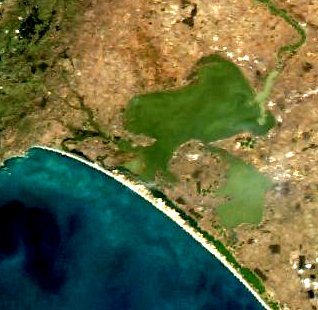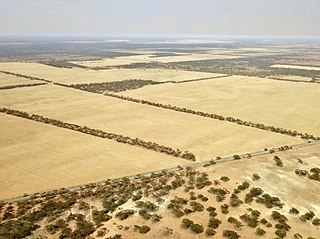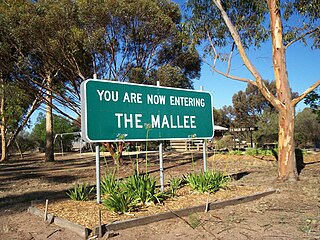
The western grey kangaroo, also referred to as a western grey giant kangaroo, black-faced kangaroo, mallee kangaroo, sooty kangaroo and Kangaroo Island grey kangaroo, is a large and very common kangaroo found across almost the entire southern part of Australia, from just south of Shark Bay through coastal Western Australia and South Australia, into western Victoria, and in the entire Murray–Darling basin in New South Wales and Queensland.
The Kaurna people are a group of Aboriginal people whose traditional lands include the Adelaide Plains of South Australia. They were known as the Adelaide tribe by the early settlers. Kaurna culture and language were almost completely destroyed within a few decades of the British colonisation of South Australia in 1836. However, extensive documentation by early missionaries and other researchers has enabled a modern revival of both language and culture. The phrase Kaurna meyunna means "Kaurna people".

Lake Alexandrina is a coastal freshwater lake located between the Fleurieu and Kangaroo Island and Murray and Mallee regions of South Australia, about 100 kilometres (62 mi) south-east of Adelaide. The lake adjoins the smaller Lake Albert and a coastal lagoon called The Coorong to its southeast, before draining into the Great Australian Bight via a short, narrow opening known as Murray Mouth.

The Ngarrindjeri people are the traditional Aboriginal Australian people of the lower Murray River, eastern Fleurieu Peninsula, and the Coorong of the southern-central area of the state of South Australia. The term Ngarrindjeri means "belonging to men", and refers to a "tribal constellation". The Ngarrindjeri actually comprised several distinct if closely related tribal groups, including the Jarildekald, Tanganekald, Meintangk and Ramindjeri, who began to form a unified cultural bloc after remnants of each separate community congregated at Raukkan, South Australia.

The Murray Mallee is the grain-growing and sheep-farming area of South Australia bounded to the north and west by the Murray River, to the east by the Victorian border, and extending about 50 km south of the Mallee Highway.

The Mallee covers the most northwesterly part of Victoria, bounded by the South Australian and New South Wales borders. Definitions of the south-eastern boundary vary, however, all are based on the historic Victorian distribution of mallee eucalypts. These trees dominate the surviving vegetation through most of Mallee,. Its biggest settlements are Mildura and Swan Hill.
The Ramindjeri or Raminjeri people were an Aboriginal Australian people forming part of the Kukabrak grouping now otherwise known as the Ngarrindjeri people. They were the most westerly Ngarrindjeri, living in the area around Encounter Bay and Goolwa in southern South Australia, including Victor Harbor and Port Elliot. In modern native title actions a much more extensive territory has been claimed.

James Unaipon, born James Ngunaitponi, was an Australian Indigenous preacher of the Warrawaldie Lakalinyeri of the Ngarrindjeri.
Ngarrindjeri, also written Narrinyeri, Ngarinyeri and other variants, is the language of the Ngarrindjeri and related peoples of southern South Australia. Five dialects have been distinguished by a 2002 study: Warki, Tanganekald, Ramindjeri, Portaulun and Yaraldi.
The Ngadjuri people are a group of Aboriginal Australian people whose traditional lands lie in the mid north of South Australia with a territory extending from Gawler in the south to Orroroo in the Flinders Ranges in the north.
In South Australia, one of the states of Australia, there are many areas which are commonly known by regional names. Regions are areas that share similar characteristics. These characteristics may be natural such as the Murray River, the coastline, desert or mountains. Alternatively, the characteristics may be cultural, such as common land use. South Australia is divided by numerous sets of regional boundaries, based on different characteristics. In many cases boundaries defined by different agencies are coterminous.
The Erawirung people, also known as Yirau, Juju and other names, were an Aboriginal Australian people whose traditional territory was located in what is today the Riverland of South Australia. They consisted of sub-groups or clans, including Jeraruk, Rankbirit and Wilu, and have been referred to as Meru people, which was a larger grouping which could also include the Ngawait and Ngaiawang peoples.
The Maraura or Marrawarra people are an Aboriginal group whose traditional lands are located in Far West New South Wales and South Australia, Australia.
The Barindji, also written Parrintyi, are an indigenous Australian people of the state of New South Wales. They are to be distinguished from the Paaruntyi, who spoke a similar language but whom they called the spitting people.
The Jarildekald (Yarilde) are an indigenous Australian people of South Australia originating on the eastern side of Lake Alexandrina and the Murray River.
The Tanganekald people were or are an Aboriginal Australian people of South Australia, of the Ngarrindjeri nation.
The Ngintait, or Ngindadj, were an indigenous Australian people of the northwest corner of the state of Victoria, and partly in South Australia. 9 people, all of one family, claim descent from the tribe, which was dispersed in the 19th century.
The Latjilatji, sometimes spelt Latji Latji or Latje Latje are an Indigenous Australian people of the state of Victoria, Australia.
The Bodaruwitj, also rendered Bedaruwidj or Potaruwutj, and referred to in some early sources as the Tatiara, are an Aboriginal Australian people of the state of South Australia. David Horton believed they were the group his sources referred to as the Bindjali people. Austlang refers to Bindjali / Bodaruwitj as alternative names for the same language.
The Ngarkat is a recorded title of a tribal group from South Australia. The Ngarkat lands had linked the mallee peoples of Victoria and South Australia to the river peoples of the Murray River Murraylands. Ngarkat language has been loosely grouped with Peramangk language though not by linguists, and the grouping was perhaps partly owed to the co-ownership of lands in both the Ninety Mile Desert and Echunga by John Barton Hack, and partly to the occasional meeting of tribes. The language of the Ngarkat was recorded as being Boraipur by Ryan in recent times though sources were not given, while it may yet be telling that the citing work concerns Mallee peoples to the east. The language may have been midway between that of mallee peoples to the east, and that of peoples to the west recorded by Teichelmann and Schurman. It is known that songlines linked the Coorong to the Mallee regions, hence went through Ngarkat land. It is also known that Ngarkat people did meet regularly with tribes to the east, at sites along the Murray.